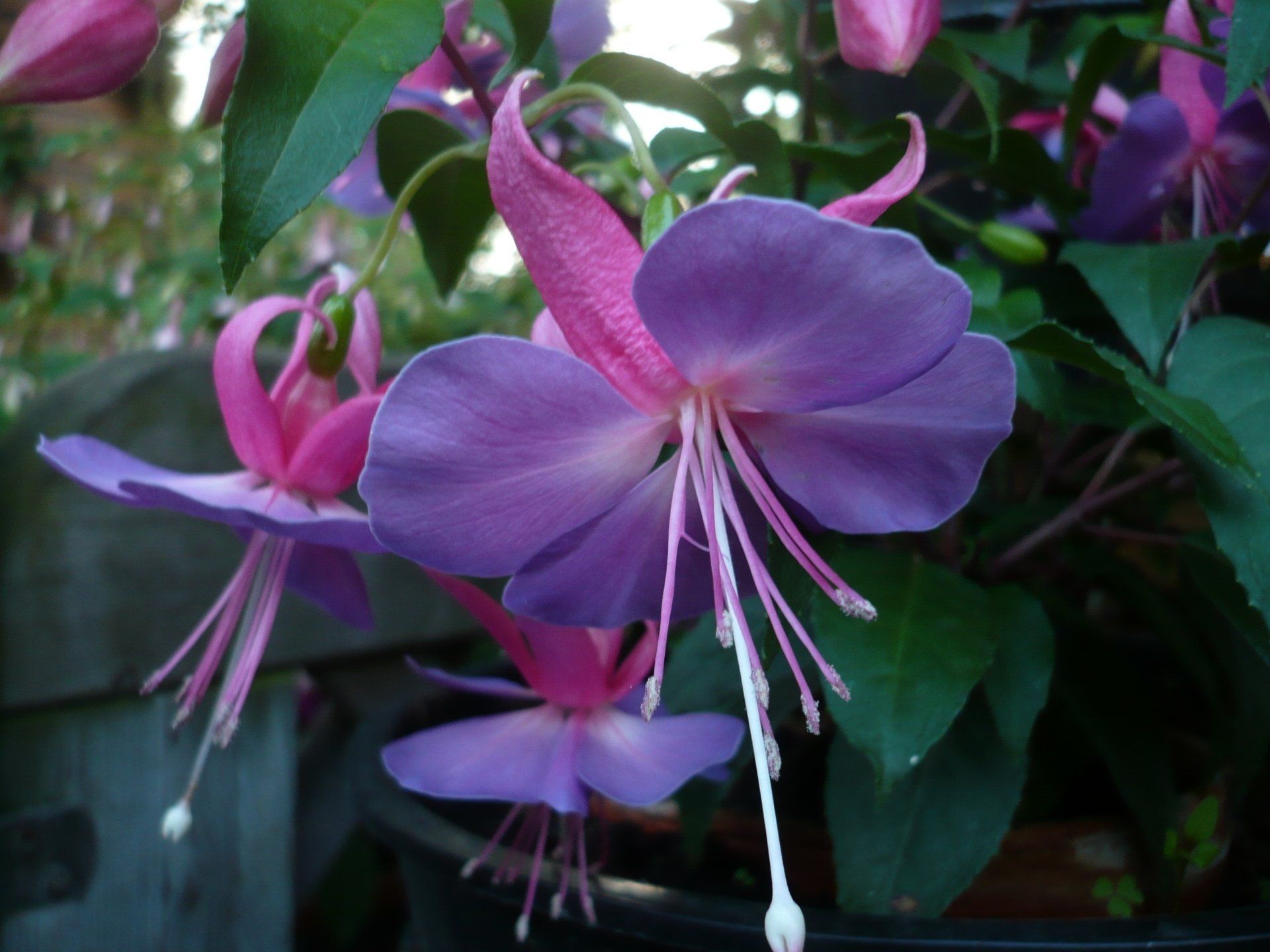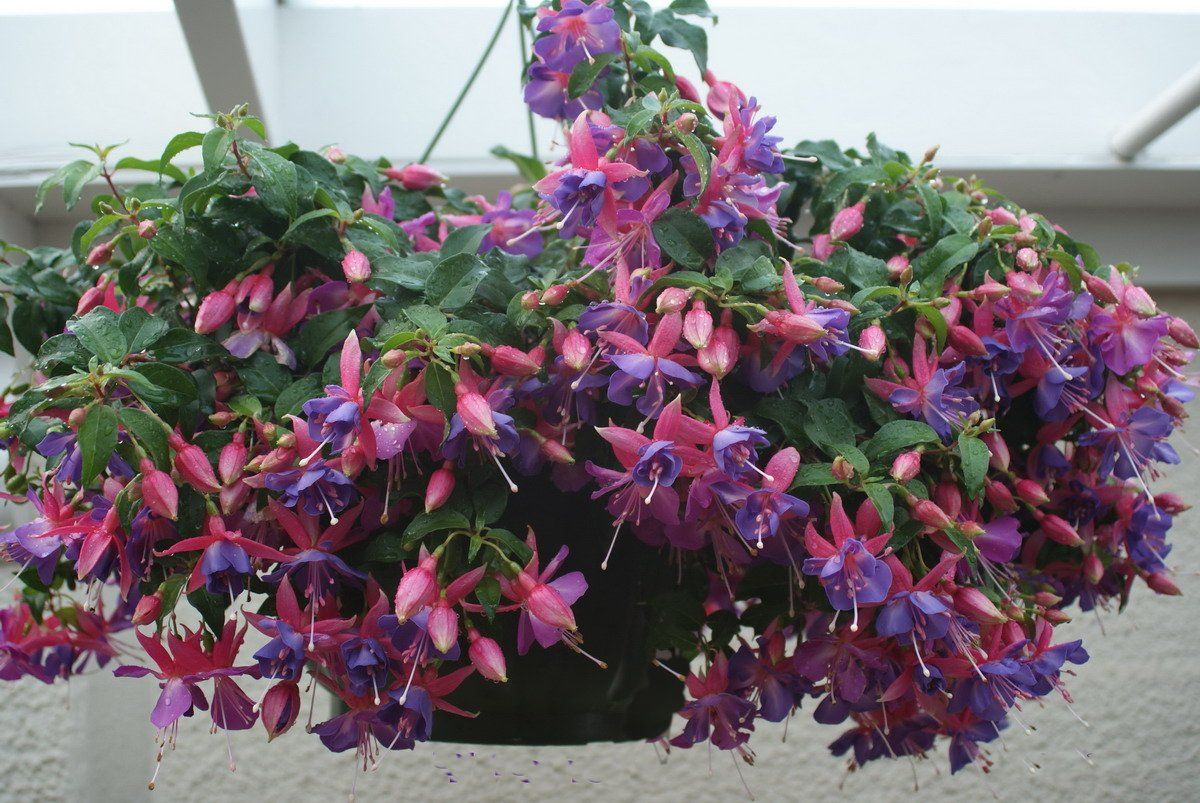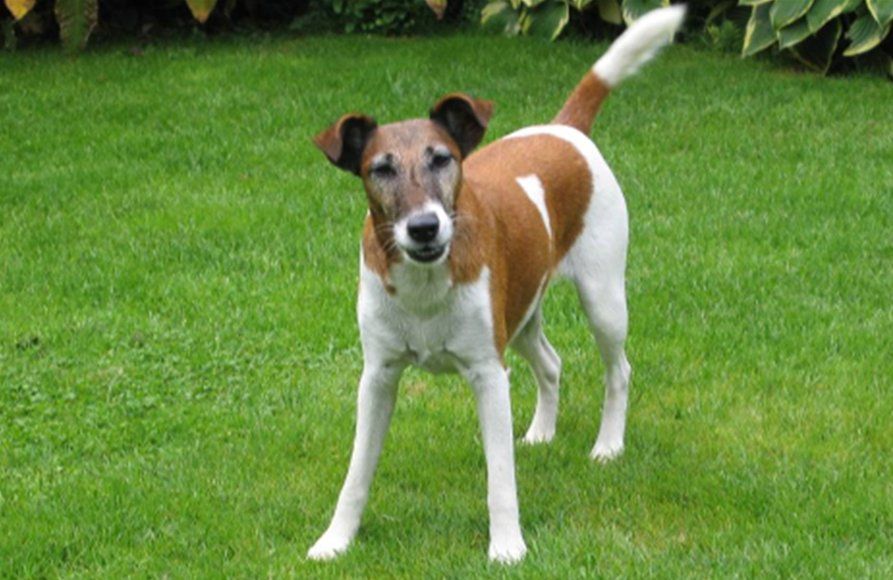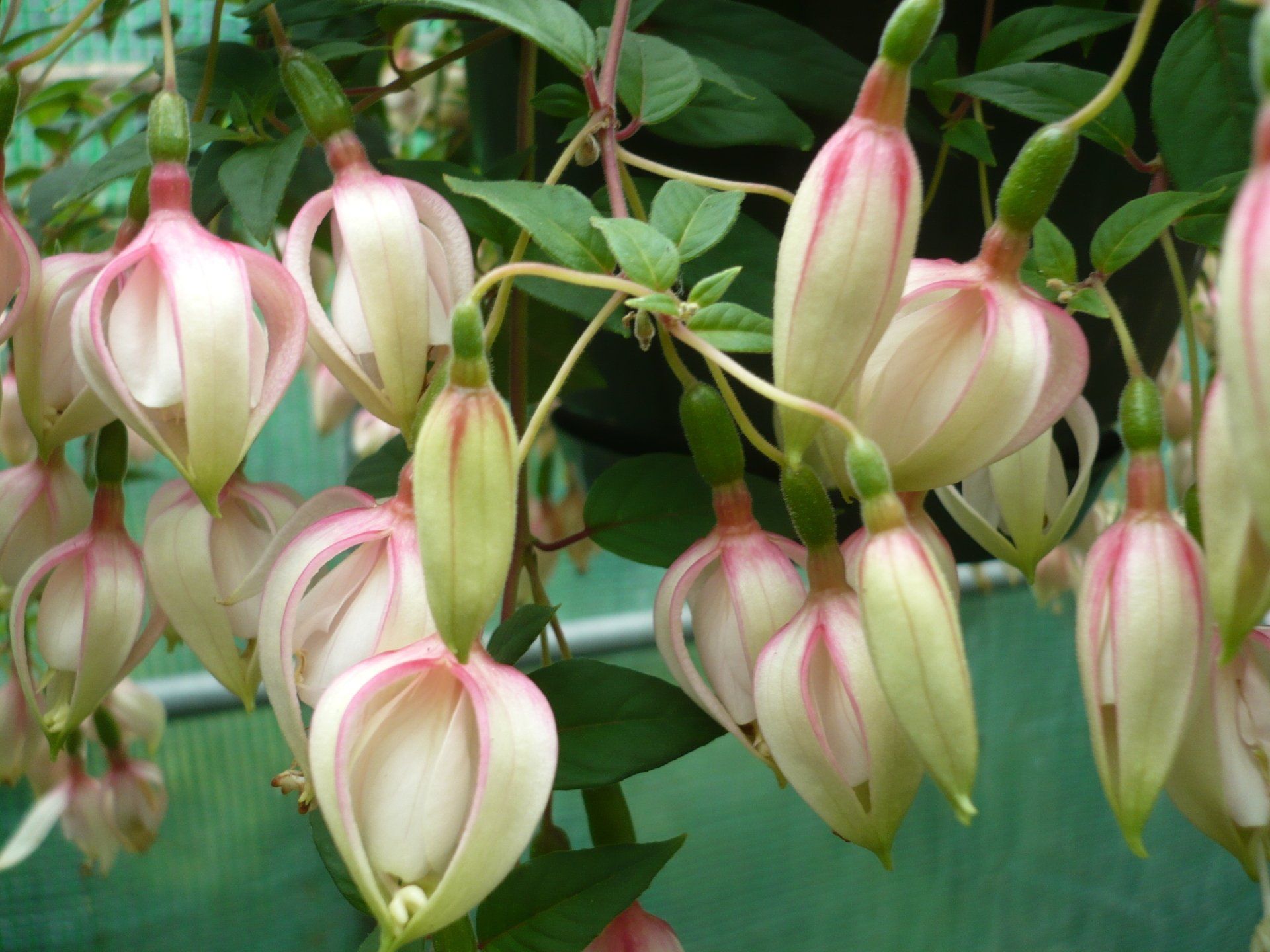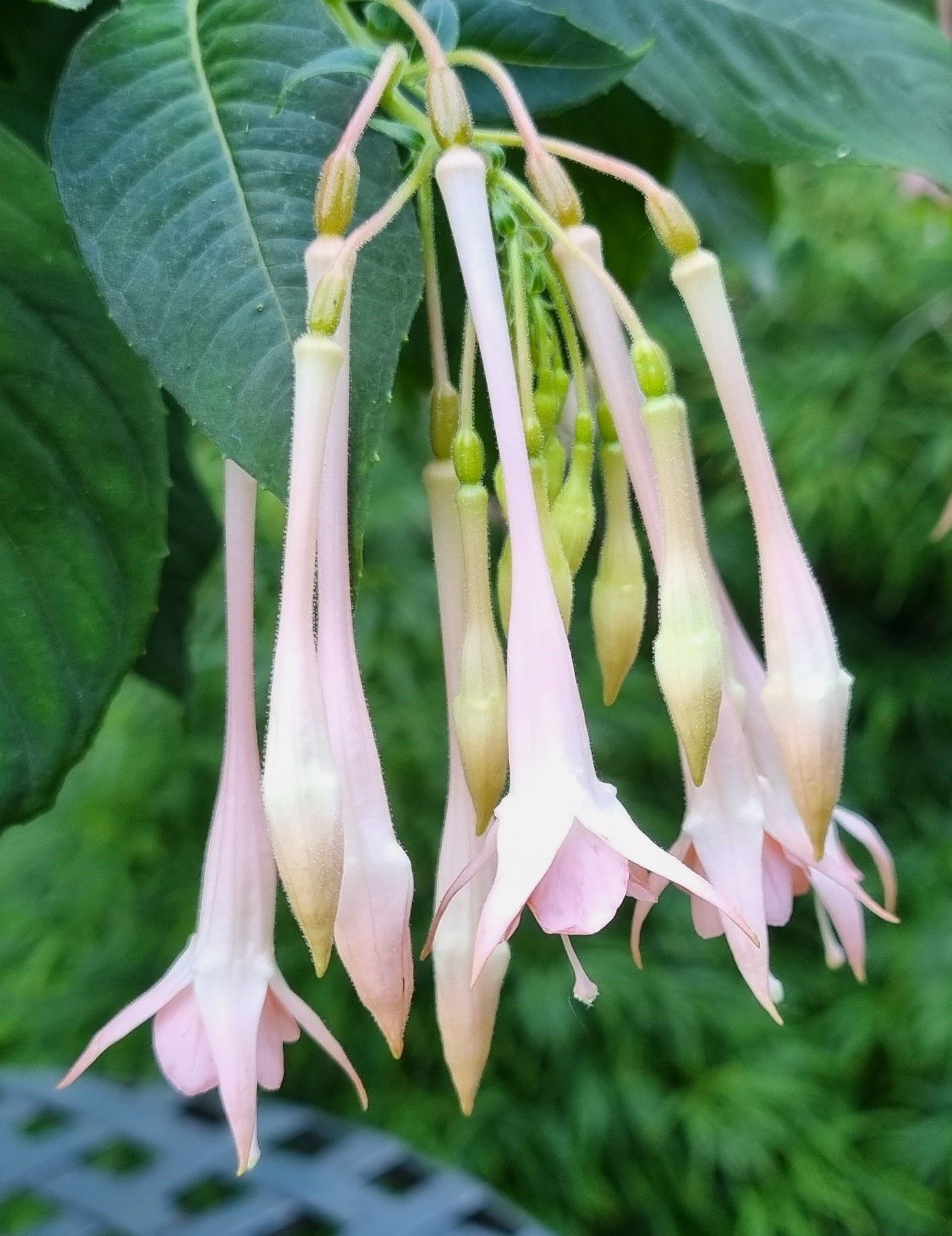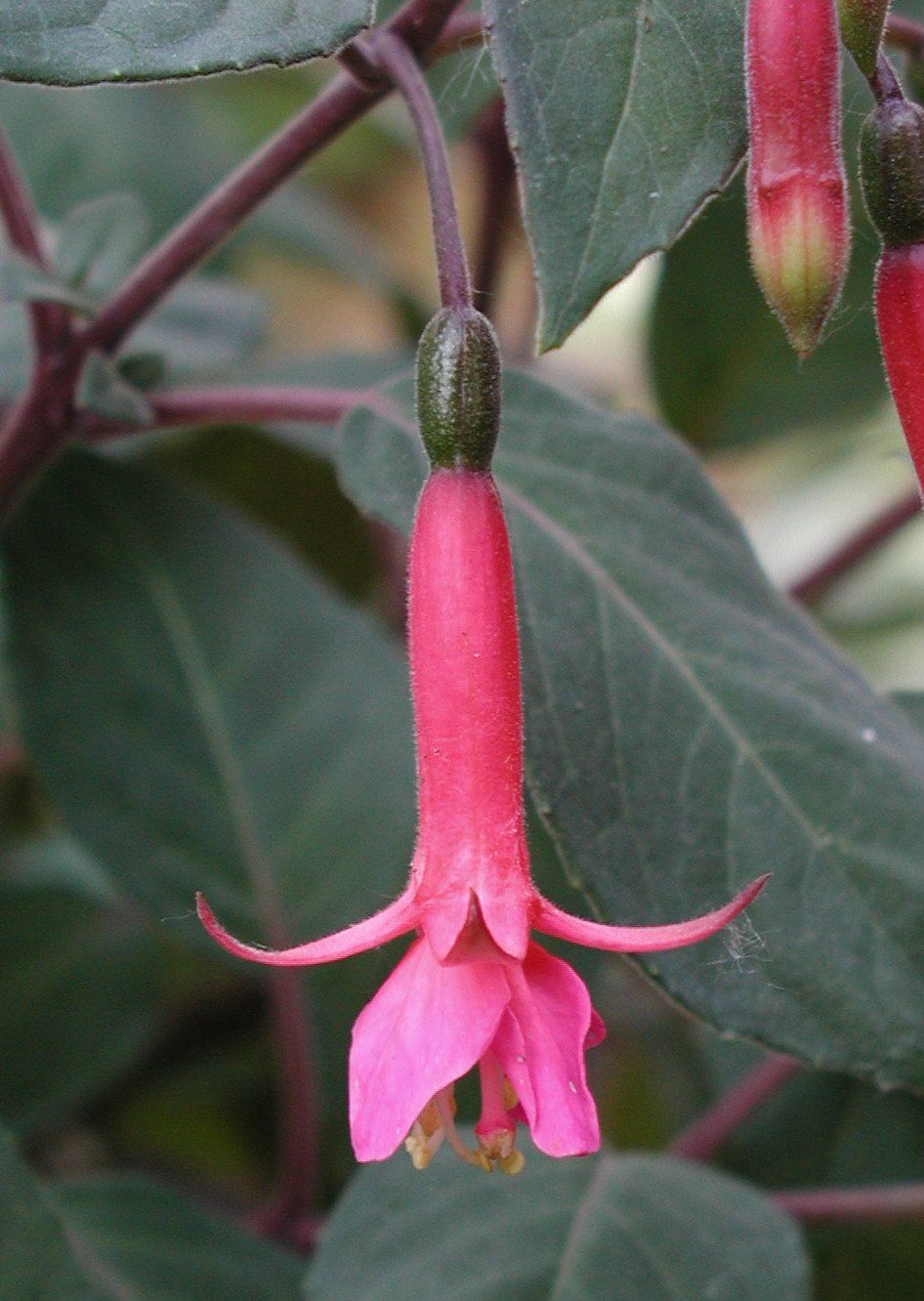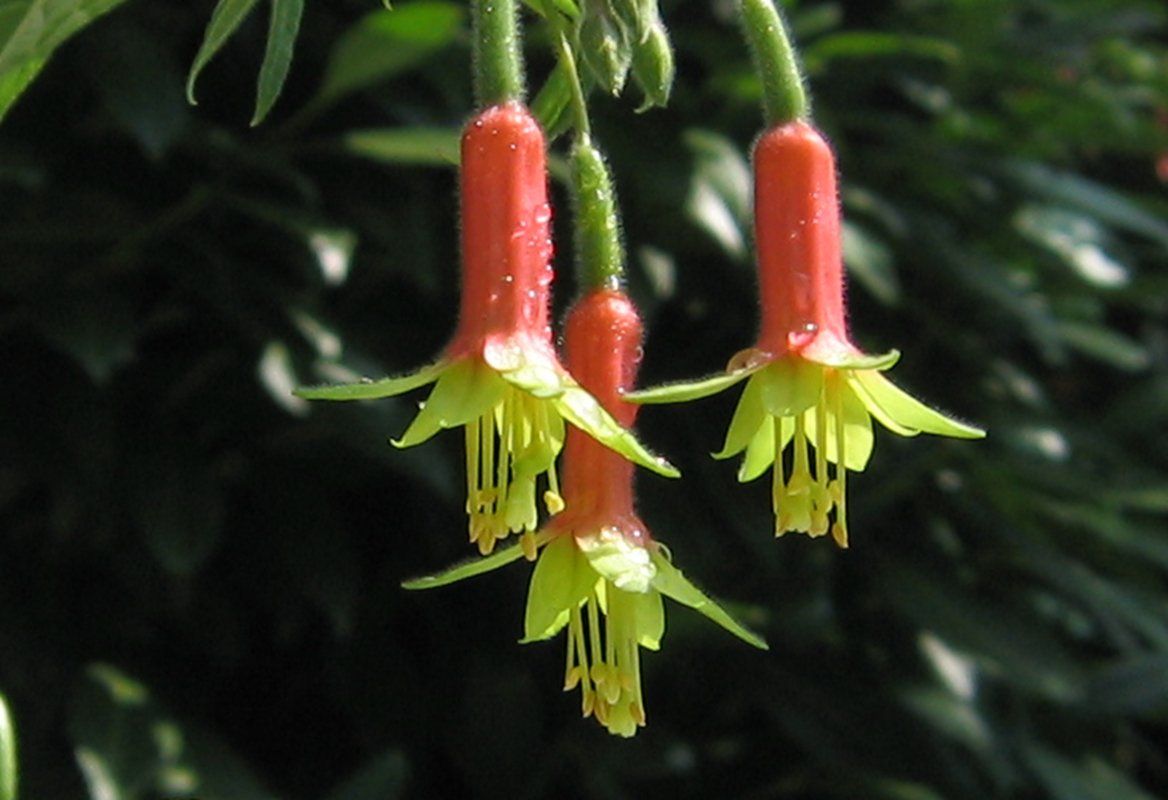Aphaia
Fuchsia ‘Aphaia’ (De Cooker, 2014), a double triphylla shaped fuchsia, originates from the crossing {‘Roger de Cooker’ x (‘Checkerboard’ x ‘Machu Picchu’) x (‘Checkerboard’ x ‘Machu Picchu’)} x ‘Blush of Dawn’. It can best be grown as a semi-trailing fuchsia or a (lash) bush, both as an older plant or from young cuttings. If grown from autumn cuttings it makes a nice floriferous pillar if it is left unpinched. Overwintering does not cause any problems and regrowth and flowering (it has double flowers) starts early in the season. The colouring of early flowers is however not at its best, as this needs somewhat higher temperatures. Heat and sun are tolerated, but the plant performs best in filtered light.
The cultivar’s name is derived from the now 9 years old Irish Terrier Aphaia.
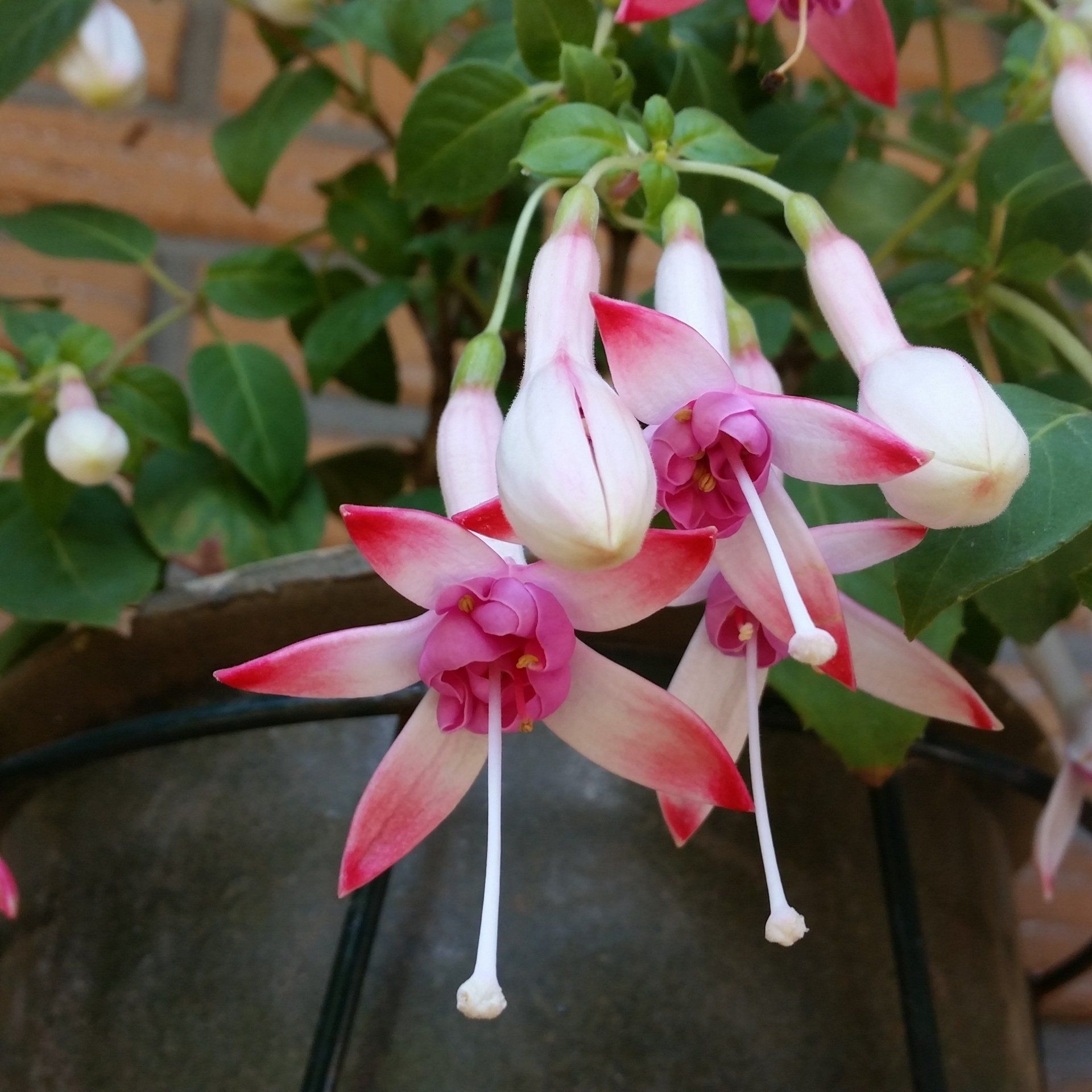
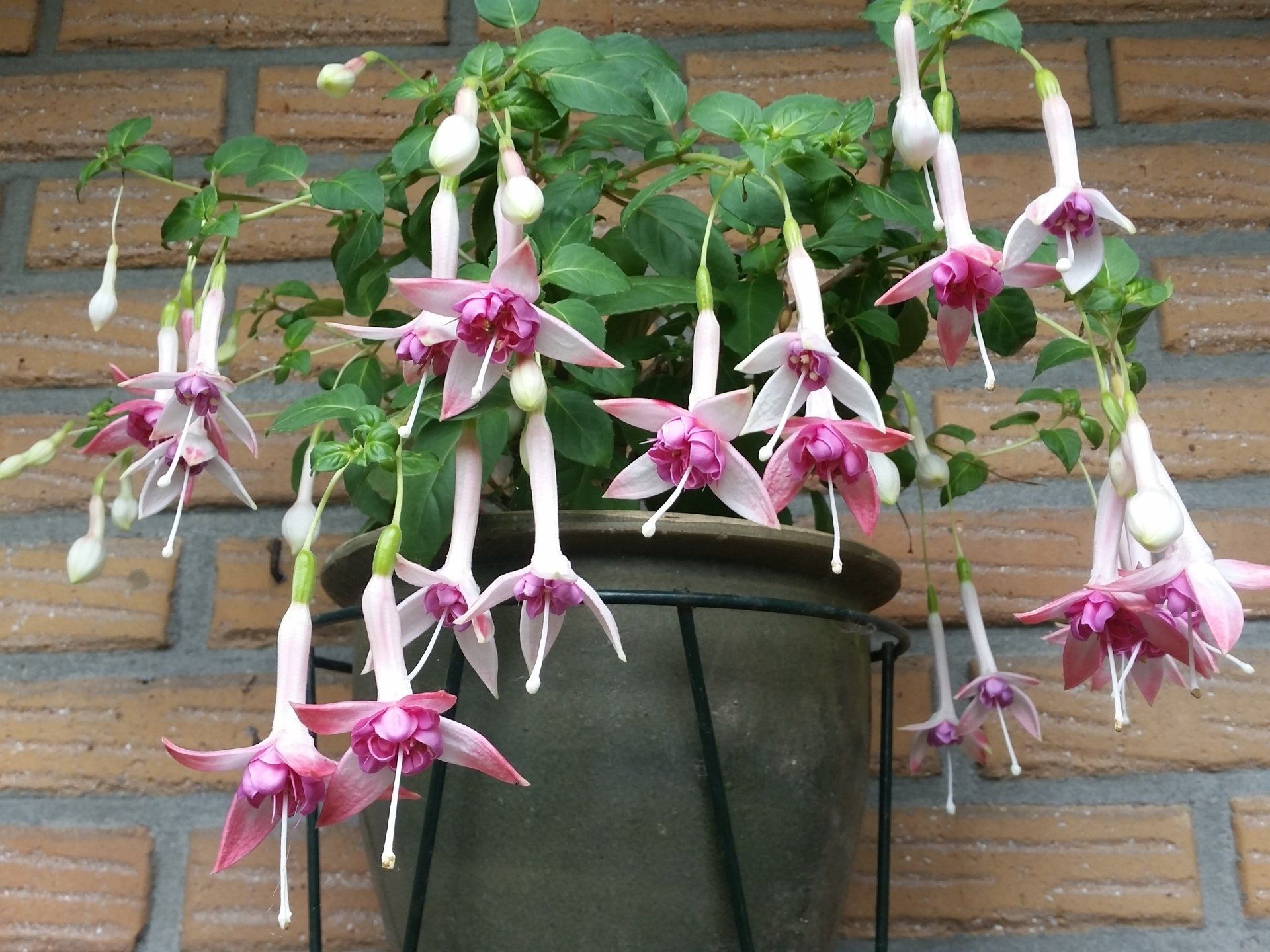
Delphobe
Fuchsia ‘Delphobe’ (De Cooker, 2011) originates from the crossing ‘Remembering Claire’ x Unknown. It is a semi-trailing variety, with nicely shaped deep purple flowers, which turn into a beautiful deep purple red upon ageing. It should be pinched once or twice. If not pinched, January cuttings start flowering already abundantly in May. Excellent results are obtained also if grown as an older plant, as a pillar or semi-trailing.
The fuchsia ‘Delphobe’ is named after one of the Airedale Terriers of the family.
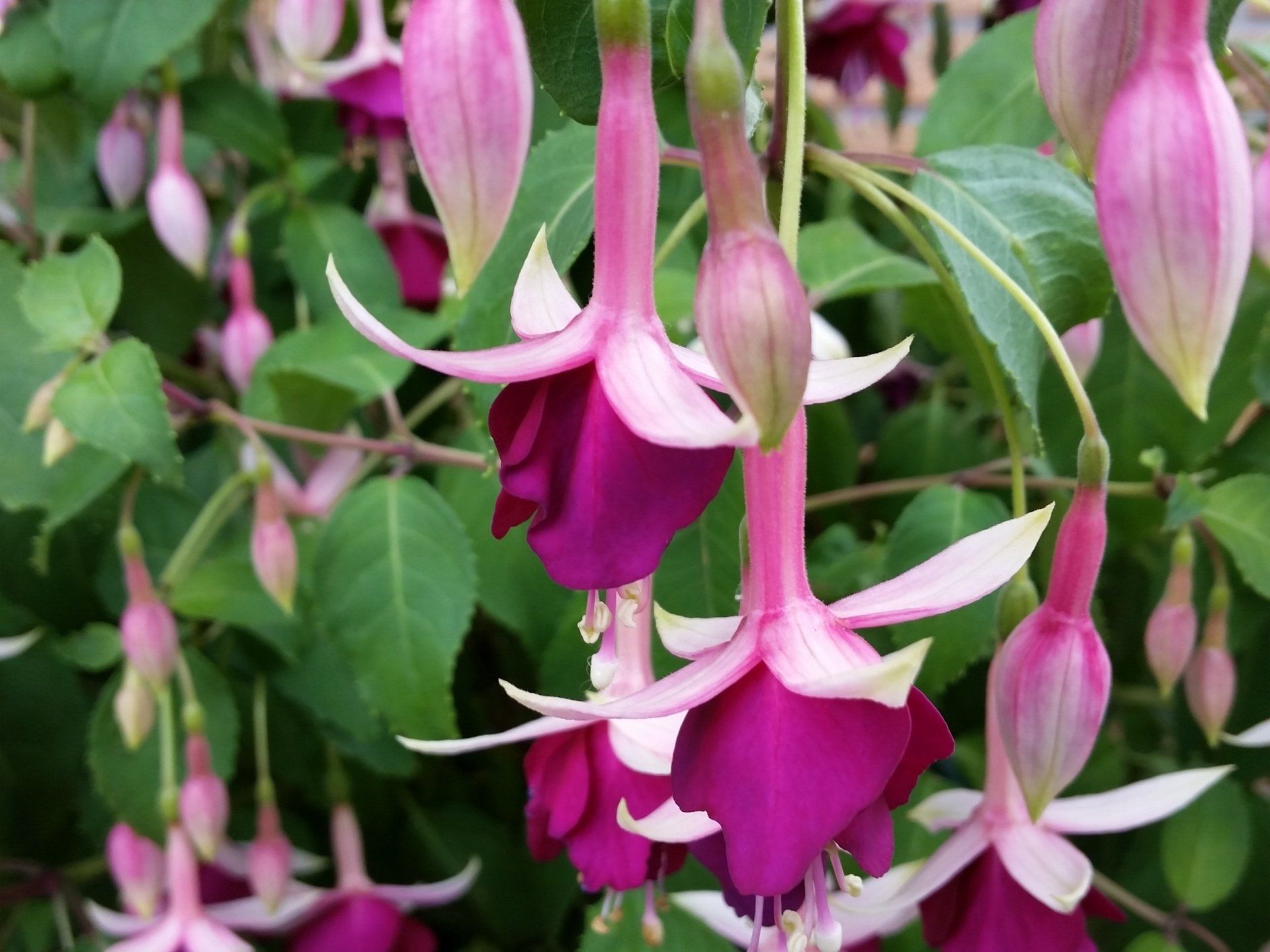
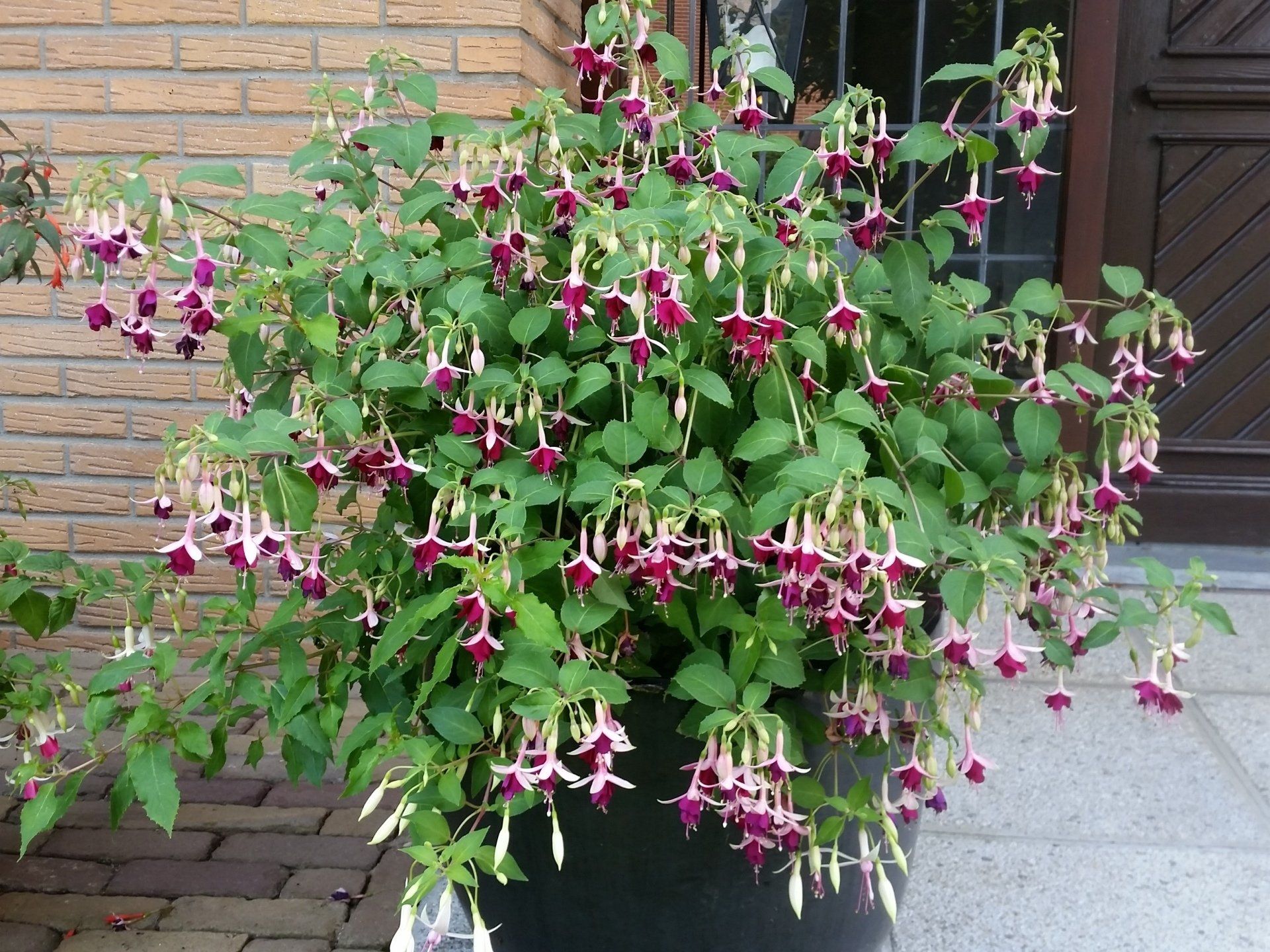
Dharlah
Fuchsia ‘Dharlah’ (De Cooker, 2011) is a vigorous, upright growing triphylla fuchsia, which can be grown both as a bush, pillar or standard. It stems from the crossing (('Göttingen' x 'Our Ted') x ('Göttingen' x 'Our Ted')) x 'Delicate White'.
Best colour of the blooms is obtained if the plant is protected from direct sunlight. Indications exist that ‘Dharlah’ has winter hardiness properties.
This fuchsia is named after one of the Irish Terriers of the family.
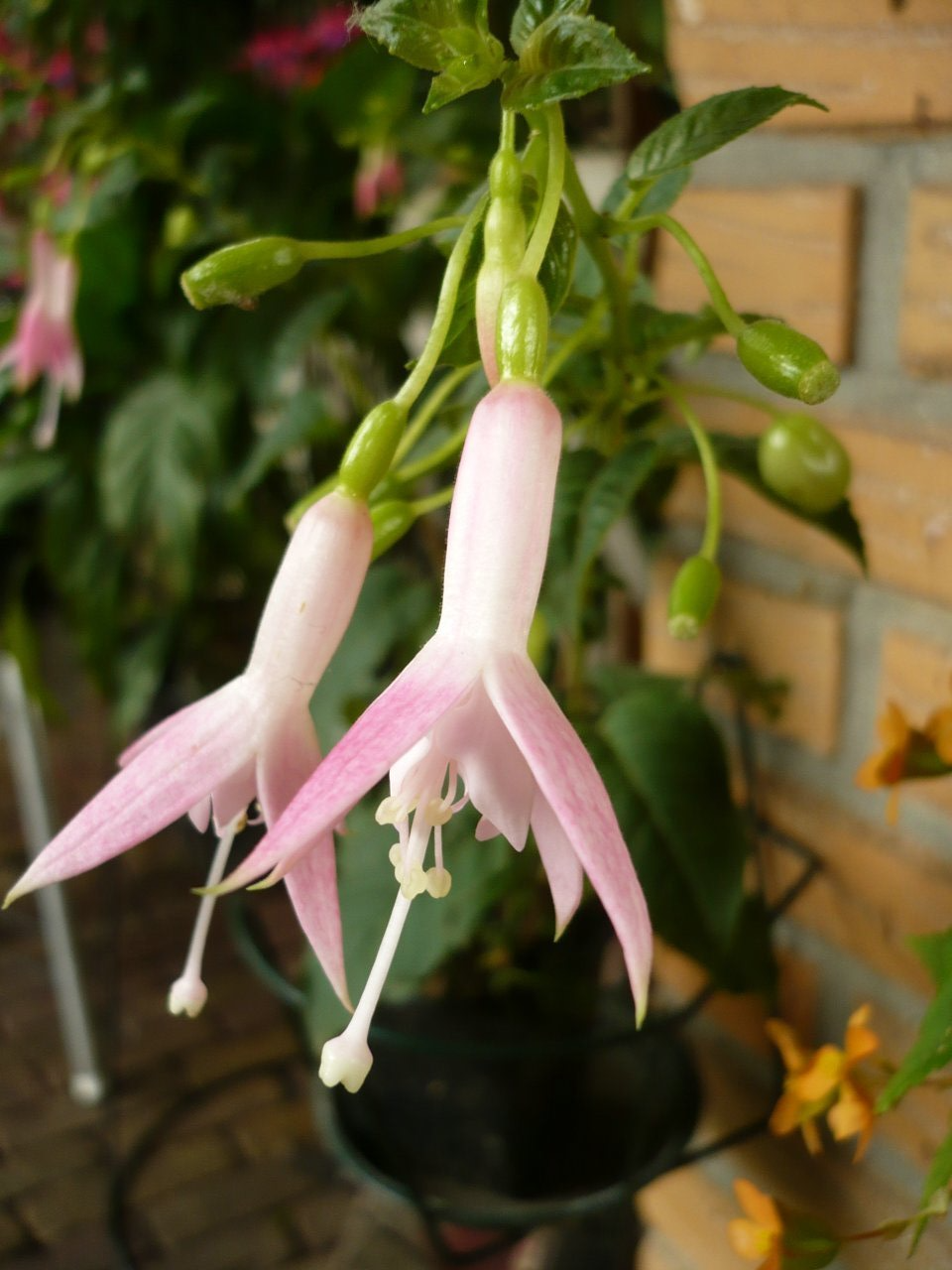

Irish Ophelia
Fuchsia ‘Irish Ophelia’ (De Cooker, 2022) originates from the crossing B 83-05 x N 16-20.
B 83-05 is a highly fertile orange pentaploid seedling, raised by Dutch Fuchsia breeder Henk Waldenmaier. It has the genome MMMMF (M = set of F. magdalenae chromosomes, F = set of F. fulgens chromosomes).
N 16-20 is a highly fertile purple hexaploid seedling, raised by Fuchsia breeder Mario de Cooker. It has the genome TTTTJJ (T = set of F. triphylla chromosomes, J = set of F. juntasensis chromosomes).
The set of F. juntasensis chromosomes in the genome is responsible for the purple colour, which is still further accentuated by the orange of F. magdalenae. The bright yellow anthers are inherited from F. juntasensis.
‘Irish Ophelia’ is named after one of the four dogs of the family: the Irish Terrier ‘Ophelia’. She is now (2023) 4 years old, she is very smart and always cheerful and ready to invite us and the other dogs for games. She’s a real challenge!
Growing F. 'Irish Ophelia' is also a challenge. But because of the beautiful triphylla flowers it is definitely worth growing her. One of the biggest challenges is making cuttings. It inherited its rather difficult rooting properties from its ancestor F. magdalenae. Once the cuttings have started to grow, it is normally not a big problem to turn them into a well-growing plant.
The plant can best be grown as a trailing fuchsia, both as an older plant or from young cuttings, several cuttings in a basket. Because the plant is late flowering, it should be pinched very early in the season, or should not be pinched at all. Flowers will then be produced at the end of July. Non-pinched plants grown from late April cuttings start flowering at the end of August. Even in the cold greenhouse in winter, the plant continues to produce many flowers. No experience has been built with overwintering at higher temperatures.
Best time for pruning is in February/March. Pruning at the end of the season is not recommended because of the danger of relapse of the older plant. Without an early pruning, overwintering and regrowth at the end of the winter season does not cause any big problems.
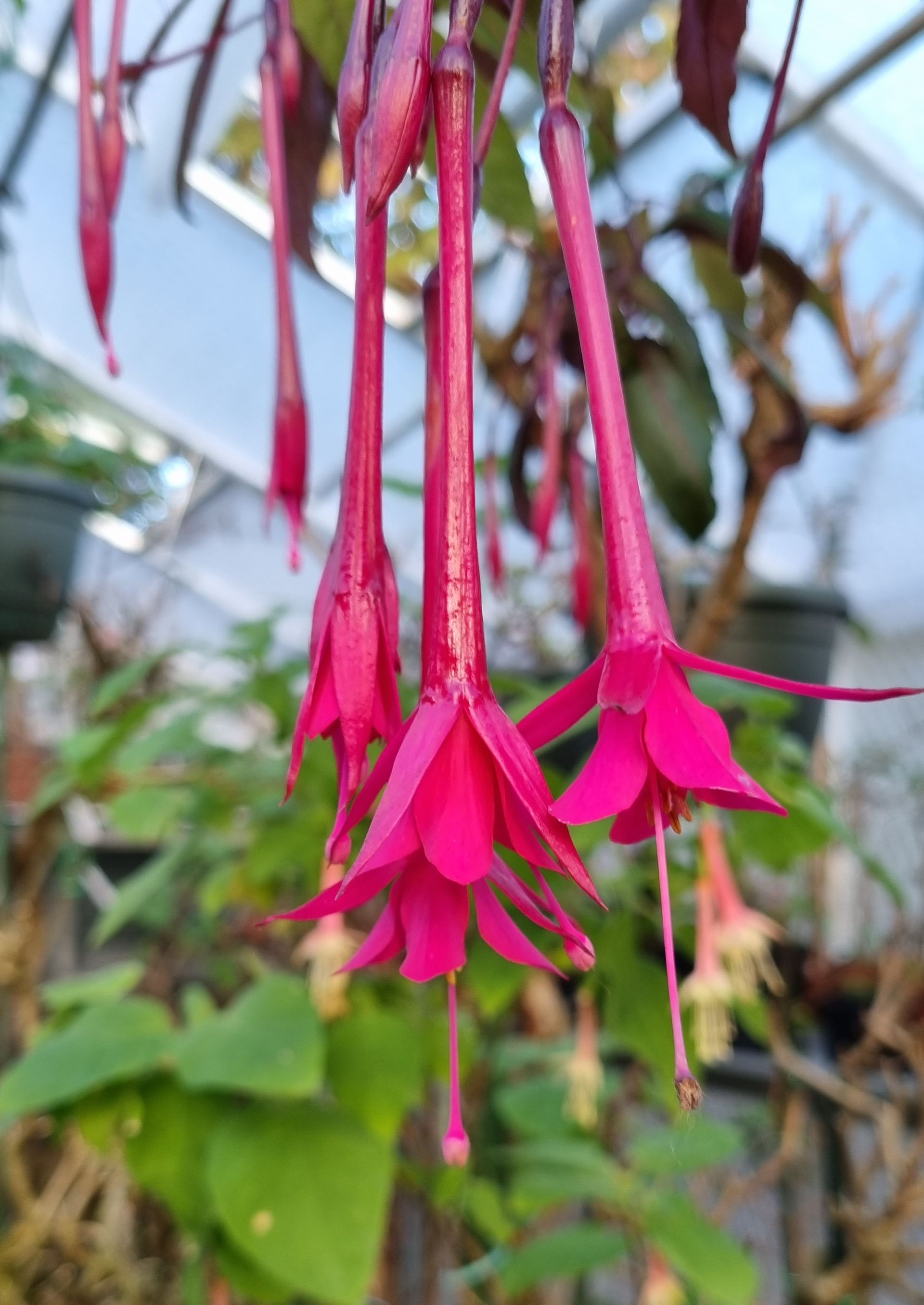
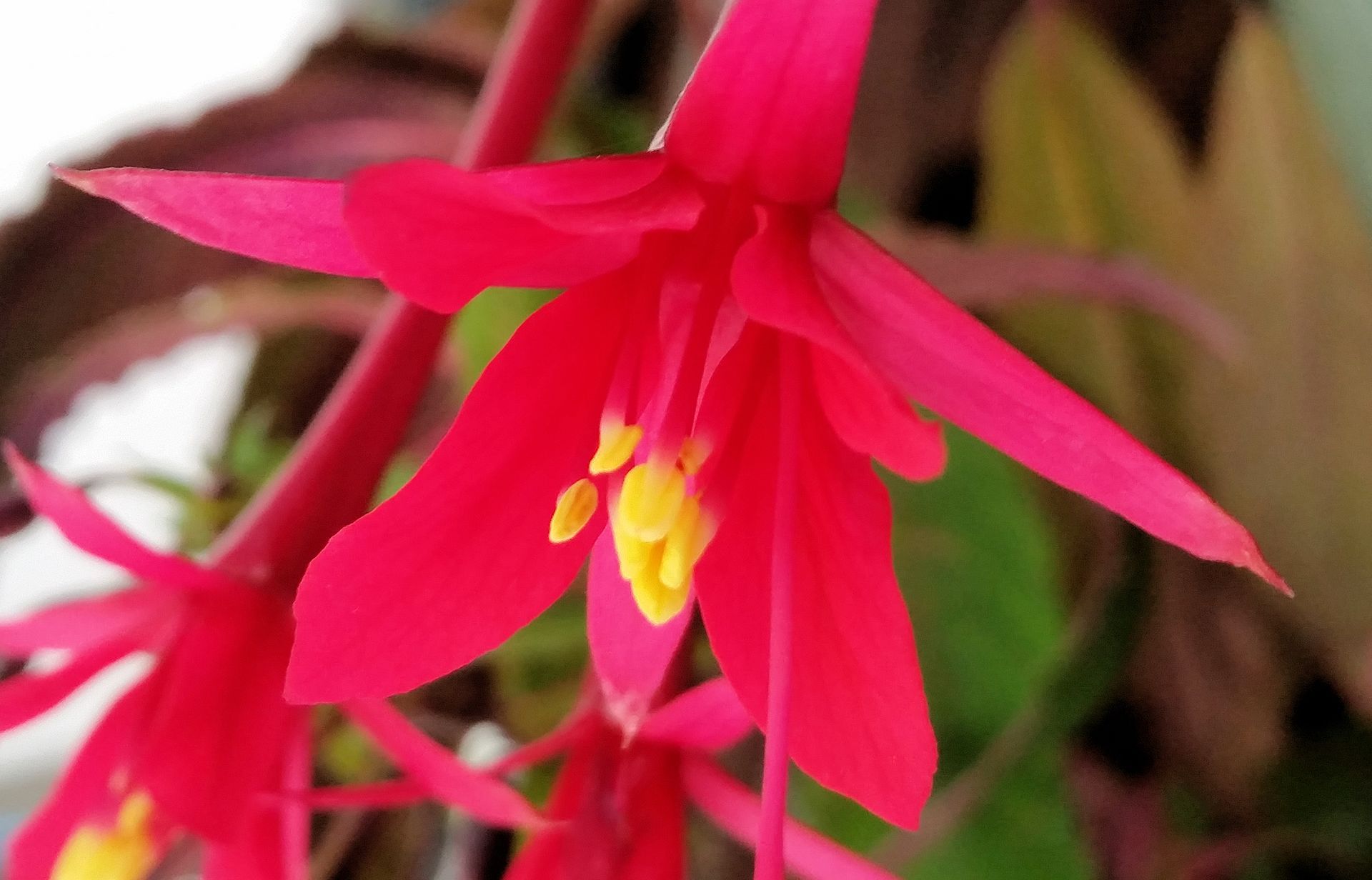
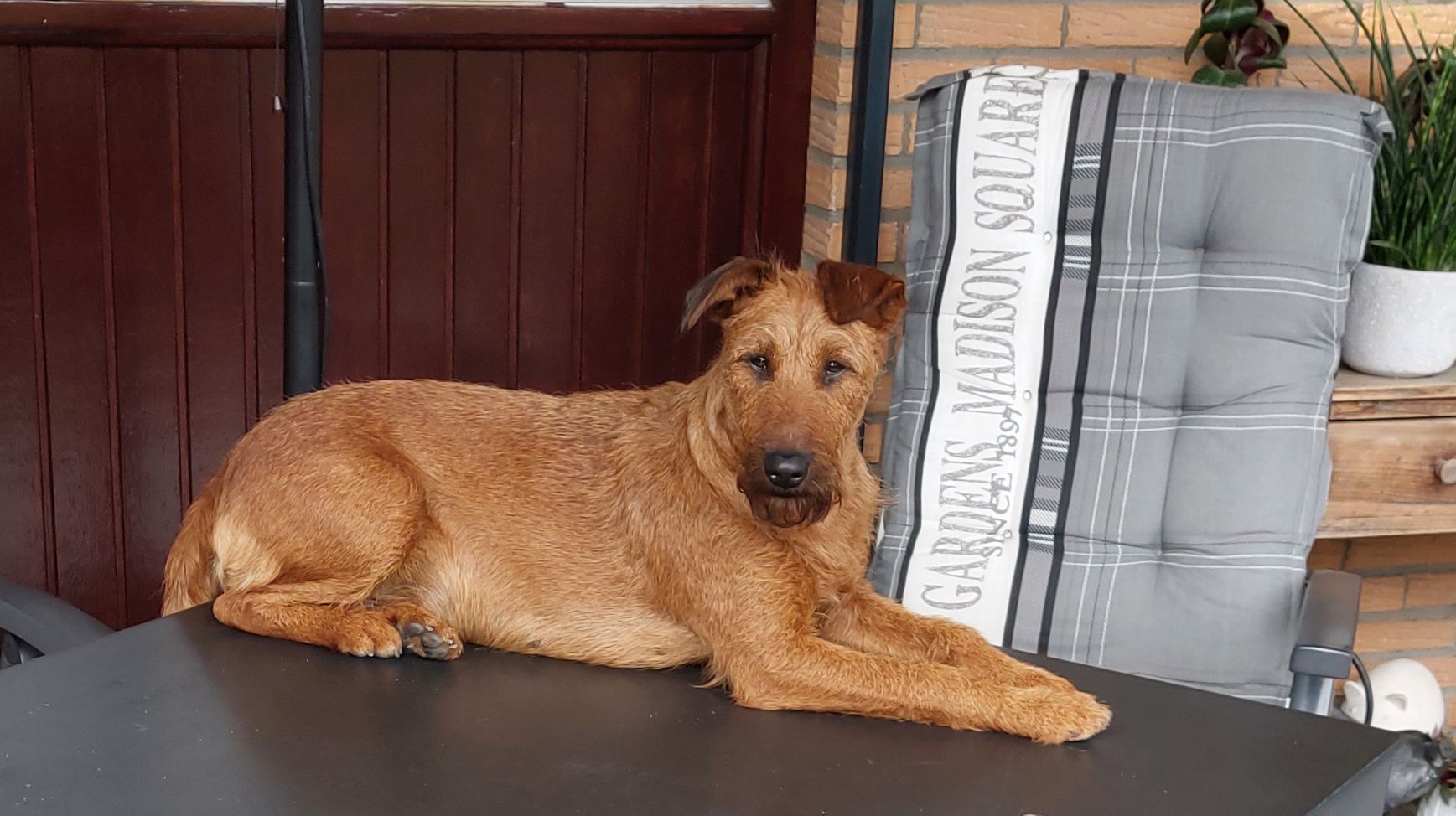
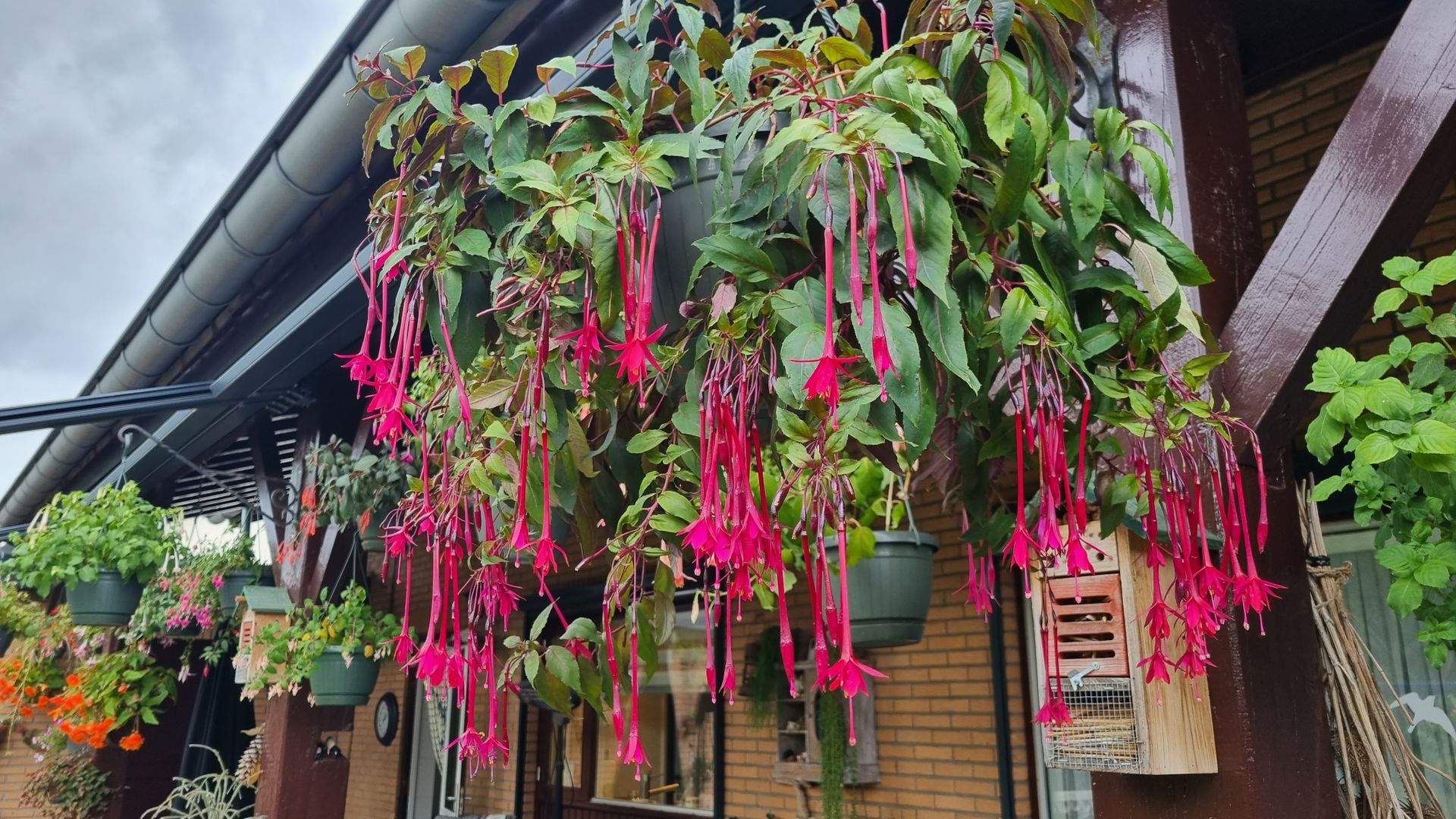
Merel
Fuchsia 'Merel' (De Cooker, 1993), a semi-trailing variety, originates from the crossing 'Speciosa' x 'Wilson's Pearls'. It has attractive lantern-like flowers of a cream/greenish-yellow colour.
Merel was our wire haired Fox Terrier († 2003), always in a good mood and ready to play. Gives best colour when grown in semi-shade. Overwintering is not a problem, but best results are obtained if grown from young cuttings, 3-5 in a basket.

Nephele
Fuchsia ‘Nephele’ (De Cooker, 2008) originates from the crossing ('Sparkling Whisper' x ('Playboy x unknown)) x 'Prince Syray'. It is an upward growing fuchsia, which performs well both as a bush or a small standard. The pink single flowers are upward looking. If the roots are protected from heat (by growing it in, e.g., a brick container) it can be put for the whole day in full sun at temperatures of at least 30 oC. This makes it also an excellent choice as a border plant.
The fuchsia ‘Nephele’ is named after one of the Irish Terriers of the family.

Our Ophelia
Fuchsia ‘Our Ophelia’ (De Cooker, 2023)) originates from the crossing N 05-31 x F. triphylla ‘Purcellian Elegancy’.
The female parent N 05-31 is a semi-trailing seedling originating from the crossing ((‘Göttingen’ x ‘Our Ted’) x (‘Göttingen’ x ‘Our Ted’)).
From the crossing it is clear that ‘Our Ophelia’ has inherited its white/soft pink colour from two sides because both ‘Our Ted’ and ‘Purcellian Elegancy’ contain the alba-form F. triphylla genes for making white flowers. It clearly inherited its shape from seedling N 05-31.
‘Our Ophelia’ is named after one of the four dogs of the family, the Irish Terrier ‘Ophelia’. Growing 'Our Ophelia' is less of a challenge than growing 'Irish Ophelia'. On the contrary, the plant is easy to grow, best as a trailing fuchsia, both as an older plant or from young cuttings, several cuttings in a basket. If grown as an older plant and pruned in October it can be overwintered in the cold greenhouse without any problems. Growth starts early in the season, and pinching is not really necessary. It makes blooms throughout the whole season on large terminal racemes.
‘Our Ophelia’ has good fertility both as the male and the female crossing partner. Flow cytometry measurements have not provided unequivocal conclusions about the genomes of N 05-31 and ‘Our Ophelia’. The 2C DNA values suggest a pentaploid genome for both plants with a substantial contribution of F. fulgens via ‘Göttingen’ and ‘Our Ted’. This is also reflected in the shape of the flowers.
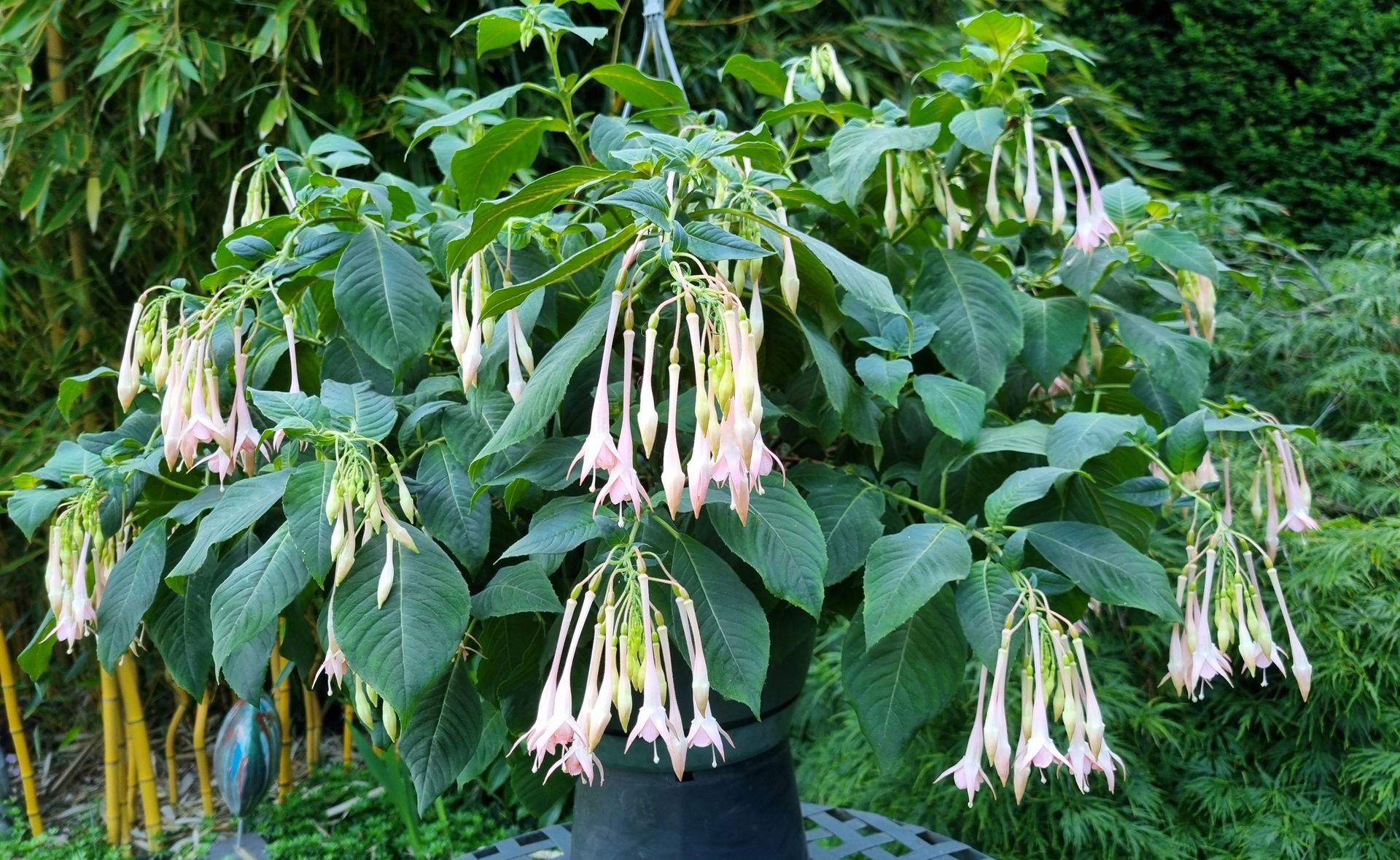
Phaenna
Fuchsia ‘Phaenna’ (De Cooker, 2016) is a cultivar originating from the crossing (‘Strike The Viol’ x ‘Delicate White’ ) x {(‘Checkerboard’ x ‘Machu Picchu’) x (‘Checkerboard’ x ‘Machu Picchu’)}. This cultivar is a spin-off from the program for developing white Triphylla cultivars.
‘Phaenna’ has been named after one of the Airedale Terriers of the family. It has a rather long tube and a small pink corolla. From the end of July onwards the corolla’s color turns into creamy hues, which creates a special contrast with respect to the tube and sepals.
‘Phaenna’ can best be grown as a small to medium sized semi-trailing plant, both raised from young cuttings or as an older plant. Overwintering in the cold greenhouse is without any problems.
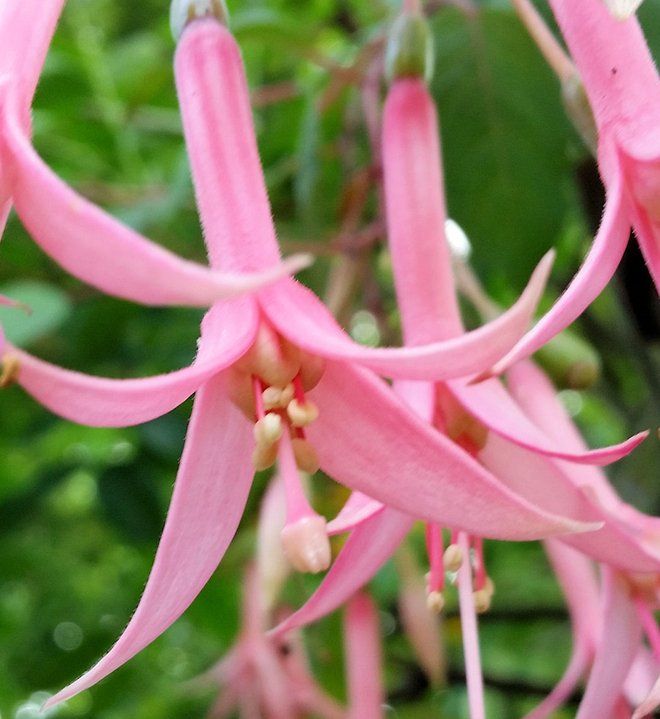

Phaidra
Fuchsia 'Phaidra' (De Cooker, 2008) originates from the crossing {(F. magdalenae x F. fulgens 'Grandiflora') x 'Göttingen'} x (('Checkerboard' x 'Machu Picchu') x self).
It is an upward growing, triphylla type Fuchsia, which performs well both as a bush or a small standard. Although it tolerates heat and sun, it is best grown in dappled shade.
The Fuchsia ‘Phaidra’ is named after Phaidra, a Welsh Terrier of the family († 2010).

Saphyra
Fuchsia ‘Saphyra’ (De Cooker, 2021) is a purple triphylla fuchsia cultivar, originating from crossing ('Daryn John Woods' x 'Purcellian Elegancy') x selfing of F. fulgens ‘Gesneriana’. It is one of the first of a series of new purple triphyllas originating from seedling N 16-20 = 'Daryn John Woods' x 'Purcellian Elegancy', which is a hexaploid plant that produces 100% purple triphylla offspring.
‘Saphyra’ has a long, thin elegant tube, inherited form F. fulgens ‘Gesneriana’. It’s an upward growing variety and can be grown as a bush, a small standard or a semi-trailing basket. It has good high temperature tolerance, but can best be grown at a dappled shade position. Overwintering in the cold greenhouse is without any problems. Because it’s not early flowering it’s recommended growing it as an older plant or starting from (non-flowering) autumn or winter cuttings.
The cultivar is named after the youngest Airedale Terrier of the family: Saphyra.

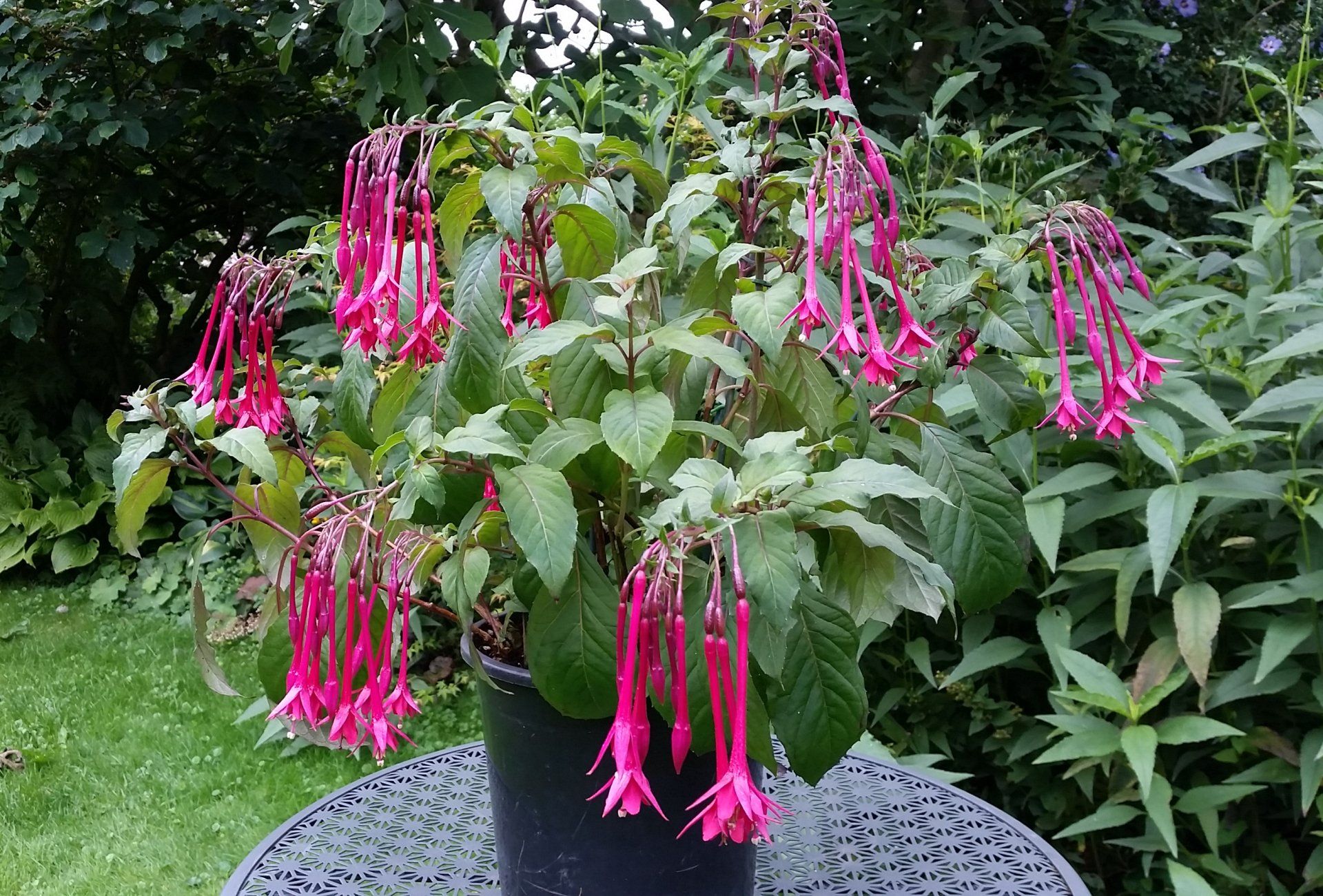

Sappho Phaoon
The trailing triphylla hybrid Fuchsia ‘Sappho Phaoon’ (De Cooker, 2011) originates from the crossing 'Wake The Harp' x (('Checkerboard' x 'Machu Picchu') x ('Checkerboard' x 'Machu Picchu')). Best colour is obtained if the pink flowers are protected from direct sunlight. It is best grown from January/February cuttings, which should be pinched once or twice. Growing an older plant is also possible, but will provide less optimal results.
The Fuchsia ‘Sappho Phaoon’ is named after one of the Airedale Terriers of the family.
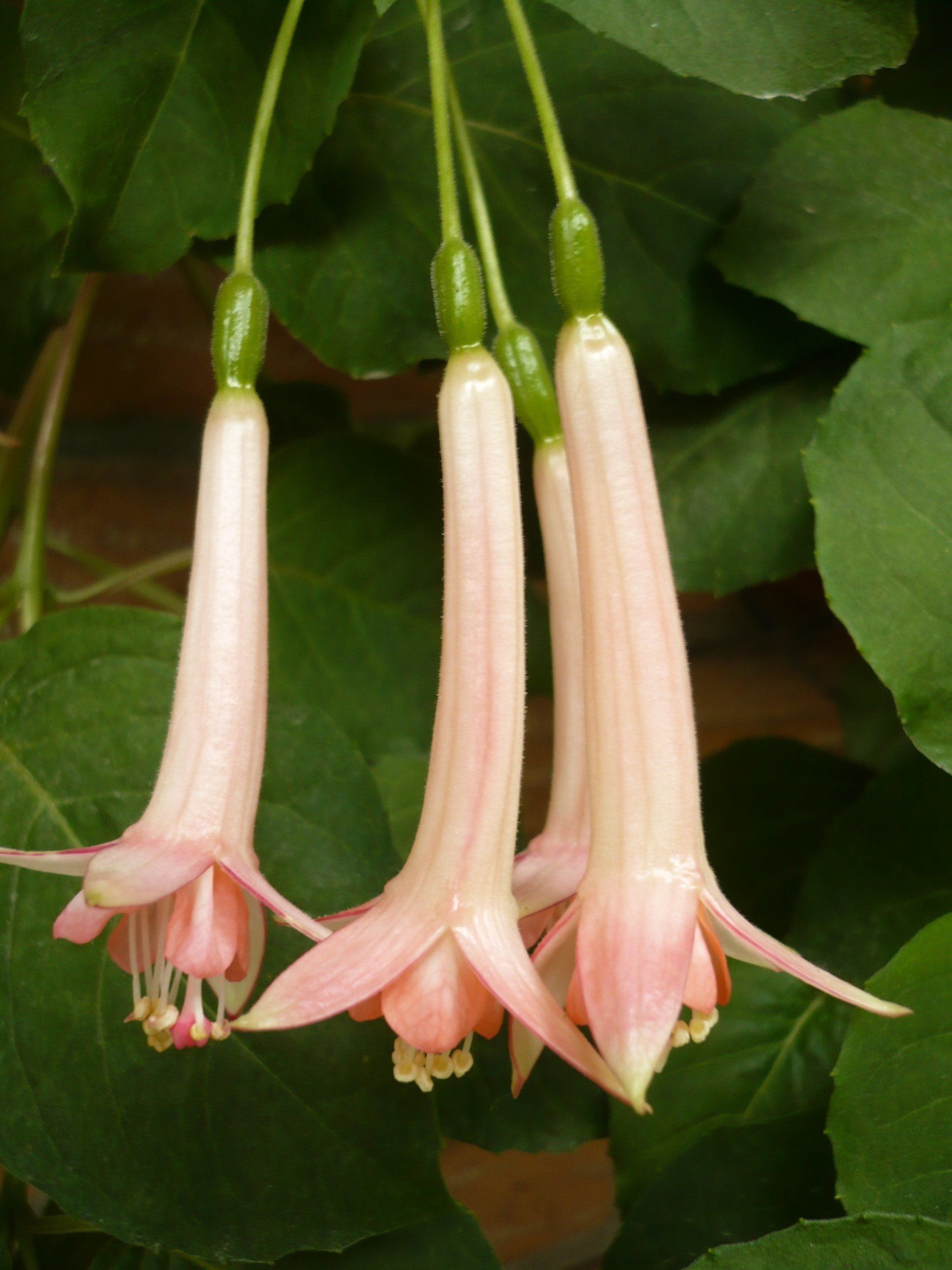

T.T. Torpedo (†)
Fuchsia 'T. T. Torpedo' (De Cooker, 1997) originates from the crossing {(F. magdalenae x F. fulgens 'Grandiflora') x 'Göttingen'} x ('Checkerboard' x 'Machu Picchu'). This cultivar is not available anymore. It was an attractive, but rather difficult to grow small plant. Finally, about 10 years after introduction, it ceased to exist because it was found to be genetically unstable.
This Fuchsia cultivar is named after one of our first Terriers: a smooth black and white Fox Terriers: Tosca van Manolito († 1996). She was fond of food, and regularly gained some weight. Sometimes she took the form of a torpedo, hence the name T.T. Torpedo, which stands for Tosca Turbo Torpedo.
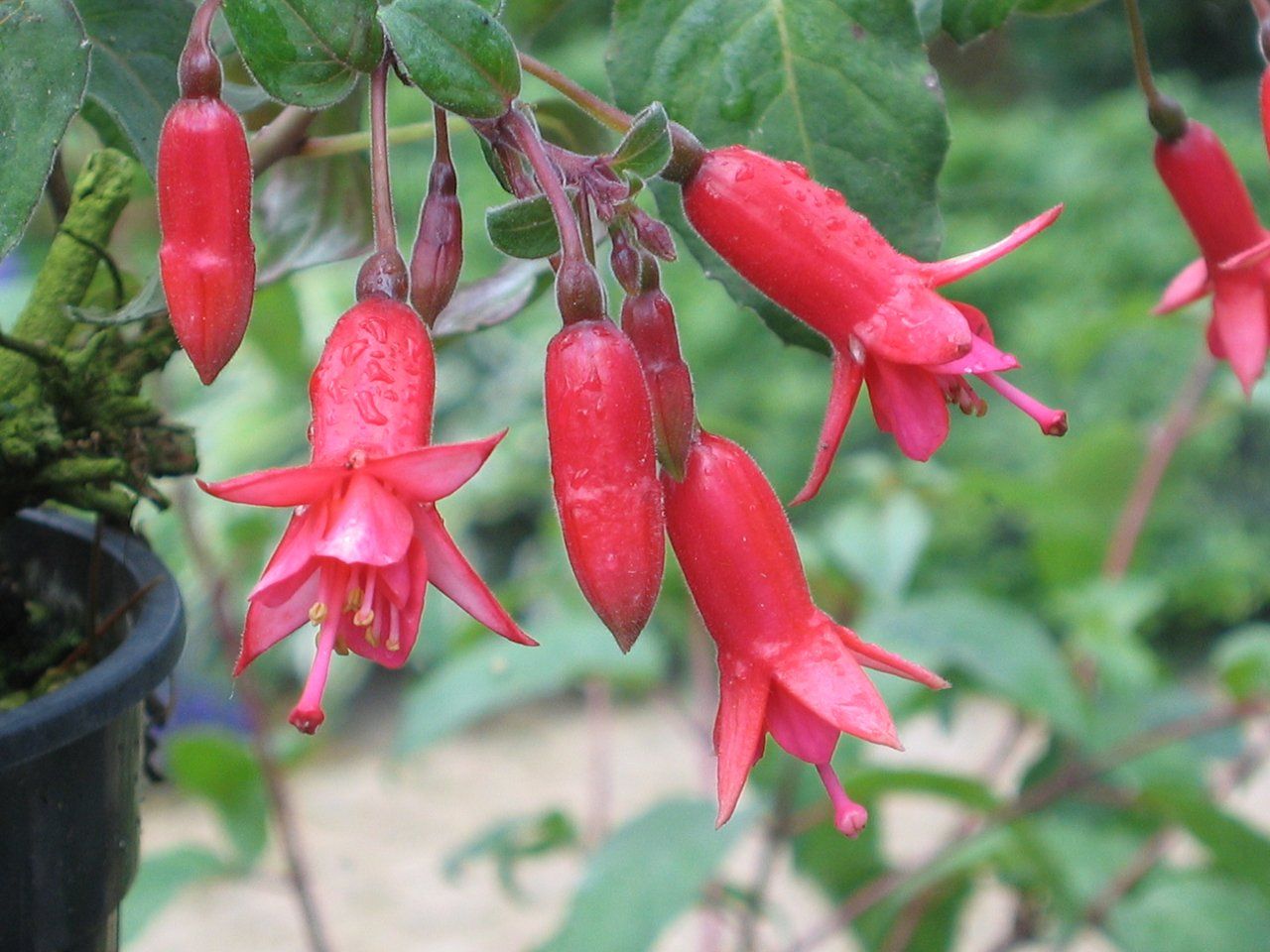
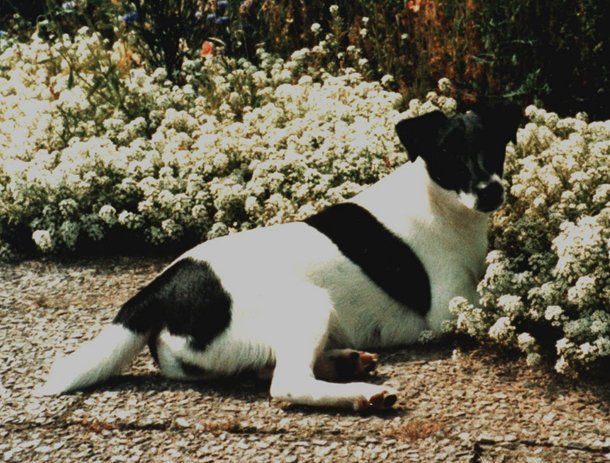
Tosca van Manolito
Fuchsia 'Tosca van Manolito' (De Cooker, 1993) originates from the crossing 'La Campanella' x 'Machu Picchu'. This Fuchsia is named after Tosca, a smooth black and white Fox Terrier of the family († 1996). 'van Manolito' is the name of the kennel where Tosca was born. She loved swimming and taking long walks and once completed with us the 'Kennedy March', which is a 50-mile (80 km) walk in honour of President John F. Kennedy.
'Tosca van Manolito' is a fairly stiff growing, early flowering Fuchsia that needs to be pinched once or twice.
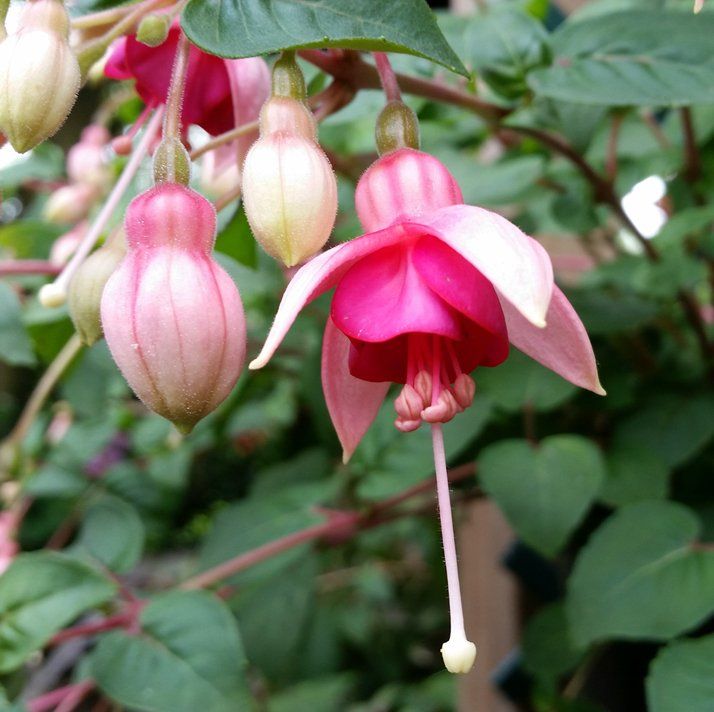
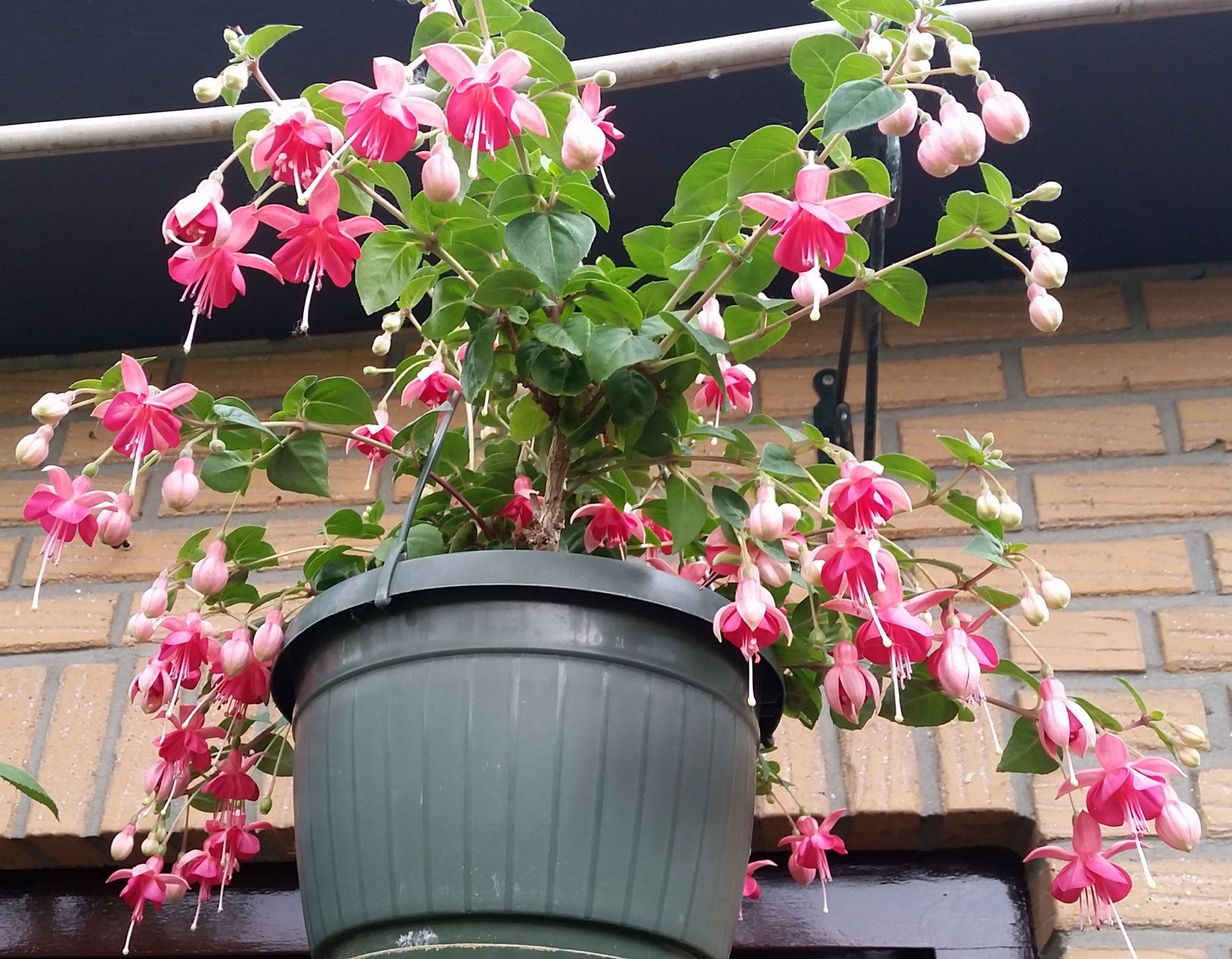
Tycha
Fuchsia 'Tycha' (De Cooker, 1999) originates from the crossing ('Playboy' x Unknown) x 'Belle de Limbourg'. This Fuchsia is named after Tycha, a smooth brown and white Fox Terrier of the family († 2010). She loved swimming in the canal and was always ready to play.
'Tycha' is best grown as a semi-trailing variety and
needs to be pinched once or twice.
